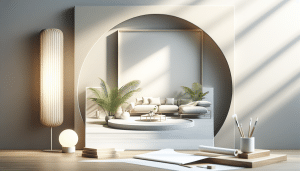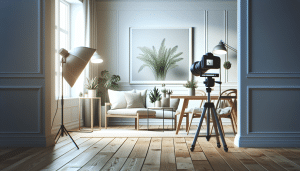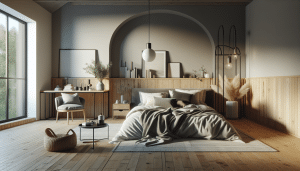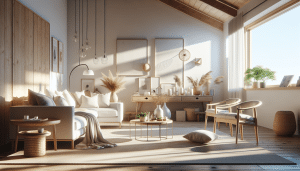Simple Home Decor Ideas That Make You Smile
Samantha Lee September 14, 2025
Transforming your living space doesn’t require a huge budget or a design degree. Explore easy home decor ideas, practical tips, and the psychology behind making interiors welcoming. Discover how to select colors, arrange furniture, and boost happiness with small, thoughtful changes—all in this guide for creating a joyful environment.
Why Your Home Environment Matters for Happiness
The feelings you experience in your home are deeply influenced by your surroundings. Research shows the design and setup of your living space can significantly affect mood and well-being. The color of your walls, the lighting in your rooms, and how furniture is arranged each play a critical role in day-to-day happiness. Small changes in your environment often lead to noticeable boosts in positivity and comfort (Source: https://www.ncbi.nlm.nih.gov/pmc/articles/PMC7329683/).
Simple home decor strategies are not just about visual appeal. Interior design can support personal goals like productivity, relaxation, or social connection. For instance, open spaces encourage family interaction, while curated reading nooks provide personal downtime. Choosing efficient storage or display options reduces clutter, which is linked directly to lower stress levels (Source: https://www.apa.org/monitor/2019/05/ce-corner-stress).
Everyone’s idea of a perfect living space is different. Personality, hobbies, and cultural preferences influence how a home is decorated. The key is aligning your space with your values and daily routines. This sense of control and personalization is central to the comfort felt at home. Intentional changes, even small, can help foster feelings of security and happiness—a sentiment echoed across lifestyle and wellness studies (Source: https://www.psychologytoday.com/us/blog/sense-and-sensitivity/201803/our-homes-our-selves).
Choosing Colors for an Uplifting Atmosphere
Color is one of the most effective tools for changing how a space feels. Soft blues and greens are known to foster calmness, while yellows and light oranges bring warmth and energy. Interior designers recommend choosing a primary shade that reflects how you want to feel in the room. Accent colors, like bold pillows or rugs, let personality shine without overwhelming the space (Source: https://www.architecturaldigest.com/story/color-psychology-interior-design).
Paying attention to natural lighting also makes a difference. Sunlit rooms can handle deeper hues, while smaller, dim spaces usually look larger and feel fresher with lighter paints. Testing paint samples before committing helps avoid expensive mistakes. Many modern brands provide eco-friendly paints with low volatile organic compounds, making decorating safer for families and pets (Source: https://www.epa.gov/indoor-air-quality-iaq/volatile-organic-compounds-impact-indoor-air-quality).
Seasonal rotation of color accents brings surprising benefits to mood throughout the year. Switching cushion covers, vases, or artwork allows for fresh visual interest and is a favorite strategy among home stylists. Keeping core furnishings neutral ensures versatility no matter what trends change. Making use of local color inspiration—like garden blooms or city scenes—helps your home feel connected to its surroundings.
Arranging Furniture for Comfort and Flow
Furniture placement has more impact than many suspect. An open layout, where couches or chairs are arranged for conversation, encourages social bonding. Designers often recommend floating furniture away from walls to create cozy groupings, rather than lining the perimeter. Area rugs help define spaces, especially in open-plan homes (Source: https://www.bhg.com/decorating/arrange-a-room/).
Clear paths help movement through the home feel natural. Avoid obstructing walkways with oversized tables or bulky storage. If space is limited, consider multifunctional furniture—like ottomans with storage, convertible sofas, or fold-out desks. This adapts rooms for different activities, from game night to quiet reading, without feeling cramped. Smart space planning also improves accessibility, making homes friendlier for guests of all ages.
Personal touches complete the effect. Incorporate art, heirlooms, or travel finds in visible places. These tell a story and increase the sense of connection to your home. Displaying sentimental items, whether it’s family photos or handmade crafts, lets happiness be part of daily routine. Rotate displays to keep things feeling new and allow your home to evolve with your experiences.
Decor on a Budget: Simple Touches with Big Effect
Refreshing your home doesn’t require a large investment. Start by repurposing what you have—move art between rooms, re-cover seat cushions, or paint old frames for an updated look. Gently used items from thrift stores or swap events can add unique character at a fraction of retail prices. DIY projects, such as crafting wall hangings or upcycling furniture, provide creative satisfaction and save money (Source: https://extension.psu.edu/decorating-on-a-budget).
Plants are a cost-effective way to add freshness and life. Even a few small succulents or a potted fern can make a space feel lively and cared for. For those concerned about maintenance, low-care species like snake plants or pothos offer greenery with minimal effort. Houseplants also support indoor air quality—a proven perk for health and happiness (Source: https://www.rhs.org.uk/advice/profile?pid=949).
Lighting is another powerful, budget-friendly tool. Soft white bulbs, floor lamps, or string lights can instantly change the ambiance. Table lamps placed in corners introduce warmth and make rooms more inviting after sunset. Replacing heavy curtains with lighter fabrics enhances natural light as the seasons change. The result is an environment that feels brighter, happier, and more organized without major renovation costs.
The Power of Scent and Sound in Home Decor
A home that delights more than one sense can be a true sanctuary. Fragrance, whether from candles, essential oils, or fresh flowers, can evoke powerful feelings of relaxation or nostalgia. Specific scents like lavender or citrus have been associated with lower stress and higher alertness. Rotating scents seasonally keeps the environment feeling fresh and supports emotional well-being (Source: https://pubmed.ncbi.nlm.nih.gov/24162709/).
Sound plays a similarly important role. Soft background music, bubbling water features, or wind chimes contribute to a soothing atmosphere. Even minor adjustments, such as adding soft textiles to reduce echoes, can make a space quieter and more peaceful. Those sensitive to noise may prefer white noise machines or curated playlists to mask outside disruptions and promote better concentration or relaxation.
Combining scent and sound turns ordinary moments—reading a book, cooking dinner, unwinding at the end of the day—into multisensory experiences. This simple habit helps mark transitions in routine and supports better sleep, focus, and contentment. Designing with the senses in mind is recommended by wellness experts as a practical approach to cultivating a nurturing home environment.
Personal Rituals: Making Your Space Truly Yours
Rituals are what transform a house into a home. These are the meaningful activities and small routines that reinforce comfort, connection, and identity. Whether it’s morning coffee by the window, family dinners, or weekly game nights, these traditions give structure and joy to daily life. Many find that starting and ending the day with intention helps create a sense of order and peace (Source: https://www.psychologytoday.com/us/blog/the-moment-youth/201706/why-rituals-matter).
Integrating personal rituals into your decor could mean setting aside a dedicated reading chair, maintaining a tidy journaling space, or hanging seasonal decorations that change with family traditions. These details evolve with life stages and keep the home’s energy positive. Home is never static—it grows and adapts as routines develop. Frequent reflection can help refine which rituals bring the most happiness and how to highlight them visually in your space.
Mental well-being experts often encourage noticing the simple joys within each day. Taking pride in a favorite vignette, cooking with fresh herbs from a kitchen planter, or pausing to appreciate art on the walls builds resilience and gratitude. Thoughtful home decor becomes a tool not just for visual pleasure but for living fully, surrounded by reminders of what matters.
References
1. Küller, R., Ballal, S., Laike, T., Mikellides, B., & Tonello, G. (2006). The impact of light and colour on psychological mood: a cross-cultural study of indoor work environments. Ergonomics, 49(14), 1496-1507. Retrieved from https://www.ncbi.nlm.nih.gov/pmc/articles/PMC7329683/
2. American Psychological Association. (2019). The stress of clutter: How disorganization affects our health. Retrieved from https://www.apa.org/monitor/2019/05/ce-corner-stress
3. Aronson, E. (2018). Our homes, our selves: The psychology of home environments. Psychology Today. Retrieved from https://www.psychologytoday.com/us/blog/sense-and-sensitivity/201803/our-homes-our-selves
4. EPA. (n.d.). Volatile Organic Compounds’ Impact on Indoor Air Quality. United States Environmental Protection Agency. Retrieved from https://www.epa.gov/indoor-air-quality-iaq/volatile-organic-compounds-impact-indoor-air-quality
5. RHS. (n.d.). Houseplants for Health. Royal Horticultural Society. Retrieved from https://www.rhs.org.uk/advice/profile?pid=949
6. Fiese, B. H., & Wamboldt, F. S. (2000). Rituals and relationships: Maintaining and enhancing family closeness. Family Process, 39(1), 15-18. Retrieved from https://www.psychologytoday.com/us/blog/the-moment-youth/201706/why-rituals-matter







